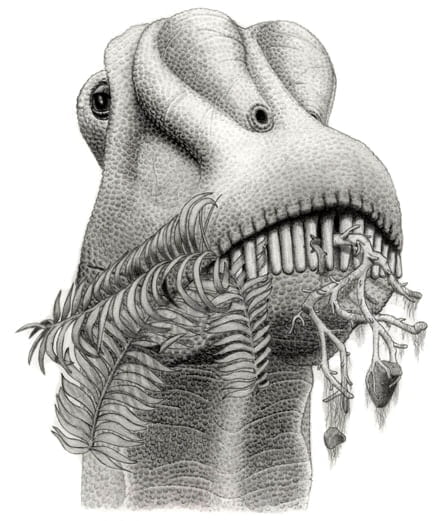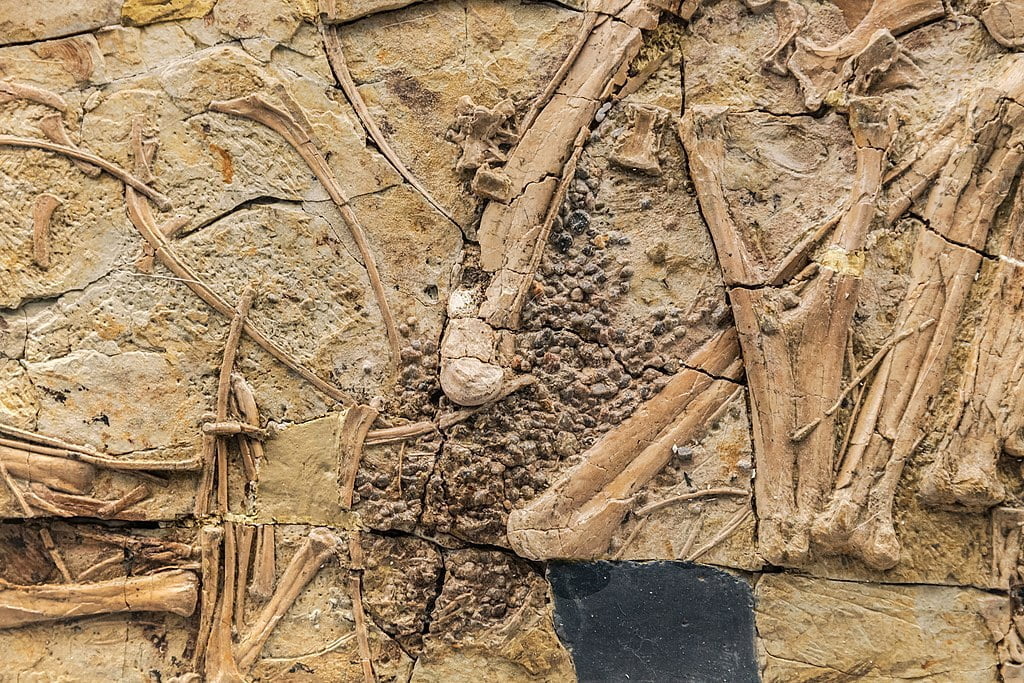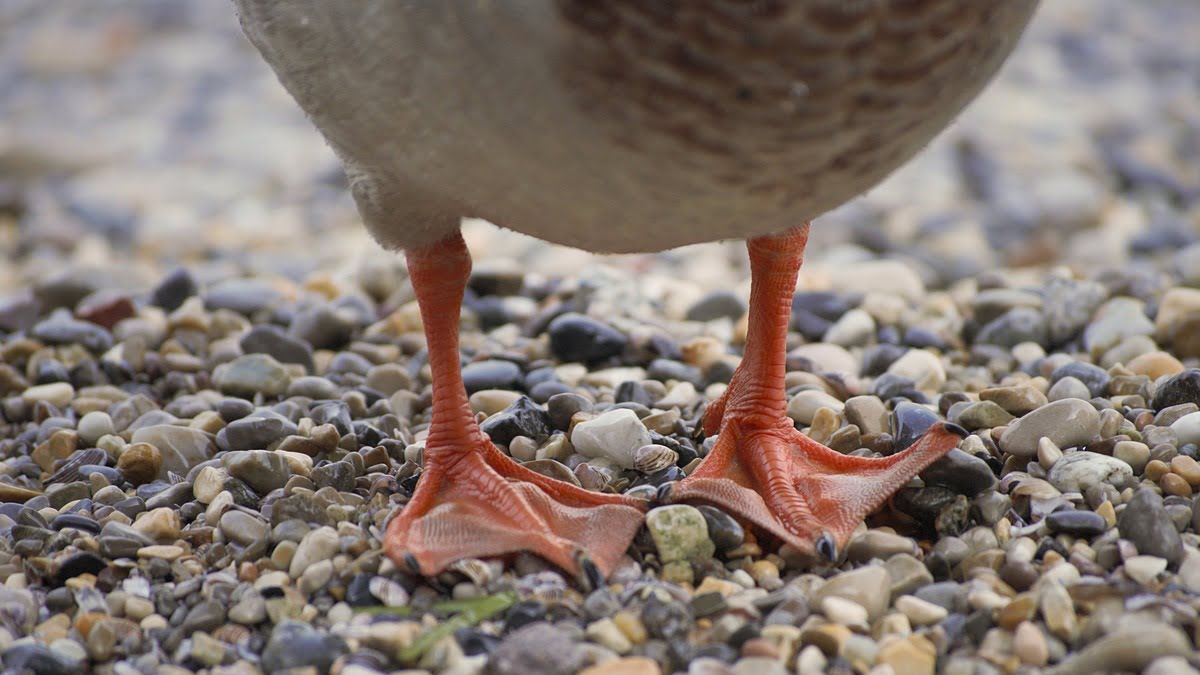In the movie Jurassic Park, the guests take a detour and discover a sick Triceratops. This scene leads to the iconic “that’s one big pile of shit” comment, as our tourists search the area for clues. Dr. Sattler makes a key discovery that the movie never explains.
She points out some West Indian Lilac (Tetrazyiga bicolor) near the dinosaur dung and is assured by the park veterinarian that the dinosaurs don’t eat this plant. She then picks up some small, smooth stones, implied to be gastroliths.
First described by George Reber Weiland in 1906, gastroliths are stones held inside the gastrointestinal tract of some animals. These stones that were first identified in plesiosaurs and sauropod dinosaurs have since been found in several other animals.
Why did dinosaurs eat rocks? Dinosaurs likely depended on gastroliths for digestion. Scientists propose that rocks help birds, crocodilians, and other animals to break down and digest food.
Modern archosaurs, the birds and crocodilians, also swallow rocks. Keep reading to discover the most likely purpose of gastroliths for dinosaurs.
Evidence That Dinosaurs Ate Rocks
How do we know that dinosaurs ingested rocks? Researchers know that various dinosaurs ingested stones because of countless fossils indicating polished stones near the gut of these animals.
While finding polished stones inside fossil remains is cool enough on its own, there are more interesting clues revealed by them. Take, for instance, a father and son who were out fossil collecting and stumbled upon possible dinosaur gastroliths.
These stones found in Wyoming have not been confirmed as gastroliths, but this conclusion would have big implications for dinosaur behavior. These stones were native to a region 600 miles away in Wisconsin, suggesting dinosaur migration habits.
Read more on this story at smithsonianmag.com. If you’re interested in finding unique fossils, check out our beginner’s guide to fossil hunting.
So now that we’ve settled that dinosaurs ate rocks, let’s explore why.
Theories About Rock-eating Animals
Could the proximity of these rocks to dinosaur fossils be a mere coincidence? That’s unlikely.
Many fossil sites revealed gastroliths in fossilized stomachs and nearby, it’s not a one-off event. Dinosaurs ate them for a reason, likely guided by instinct tied to a physical need.
Researchers have found gastroliths in various species of dinosaurs, birds, crocodilians, and aquatic mammals. Sauropods, ceratopsians, and theropods alike have been found with gastroliths, making it a common practice for dinosaurs with varied diets and dental structures.
Defining the purpose of gastroliths for all animals is beyond the scope of this article, though I will briefly showcase a few examples. This will help pinpoint why dinosaurs in particular used them.
Dinosaurs May Have Ingested Rocks For Nutritional Benefit
Some researchers suggest that stones helped provide minerals as nutrients that supplemented their particular diets. In nature, animals routinely seek out specific items to fill a nutritional void.

The idea that dinosaurs viewed rocks as a food source remains speculative. Though plausible, it does not tell the whole picture. As stated earlier, different species practiced this behavior though their diets varied widely.
Some have proposed that animals may consume gastroliths to feel fuller in times when food is scarce. While this makes sense on the surface, I doubt it holds any merit when viewed more closely.
Hunger is a natural urge to drive an animal to take action. Suppressing discomfort would not address the greater issue and makes little evolutionary sense. See rockngem.com for more on this and similar proposals.
Were Gastroliths Consumed by Mistake?
What if gastroliths were consumed by accident? That’s what Oliver Wings of Germany’s University of Bonn concluded. You can explore his claims further on sciencenews.org.
The proponents of this hypothesis neglect to mention how widespread the consumption of gastroliths is by various animals adhering to different diets. Why only members of these species and not all animals?
Consider for a moment, the sauropods. The sauropods are famous for their long necks that they likely used to graze from trees. It’s unclear how much ground grazing they would perform to randomly ingest rocks.
To learn more about sauropod necks and view debates over their actual posture, take a look at our article: Jurassic Park Dinosaurs Illustrated with Modern Science.
While sure, the polished gastroliths in non-avian dinosaurs do not resemble those of modern dinosaurs, this does not mean that they weren’t used in the same way. Do animals selectively pick stones?
Did Dinosaurs Use Gastroliths For Ballast?
Did dinosaurs use rocks for ballast? While this may sound bizarre, this usage has been suggested by many to explain gastroliths in swimming animals.
Many of the animals found with stomach stones were diving creatures. The premise of this claim is that stones in the stomach could add stability and help animals remain submerged more easily.
Think about the last time you were in a pool. By inhaling and expelling air, you can see the impact on your body’s tendency to float or sink in water.
Watch this video of Stellar sea lions (Eumetopias jubatus) selecting stones to swallow. Notice how these animals select stones. This contradicts the assumption of accidental ingestion.
Naturally, you may wonder how many stones would need to be swallowed to provide ballast for a dinosaur. Paleontologist Don Henderson had the same question and came to a staggering conclusion.
Using computer models of crocodiles, a paleontologist named Don Henderson found that gastroliths in living crocodiles and in fossil marine reptiles typically make up less than 2% of body mass. Gastroliths would have to be more than 6% of body mass to have much of an effect on buoyancy. Below that level, the filling and emptying of the lungs with air has a much greater effect of buoyancy.
https://ucmp.berkeley.edu/taxa/verts/archosaurs/gastroliths.php
Imagine a 12-ton Spinosaurus consuming stones for ballast. To achieve a 6% ratio, it would require more than 1,400 pounds (635 kilograms). This makes this conclusion improbable.
Gastroliths For Digestion
Gastroliths in dinosaurs may have served as digestive aids. Paleontologist Robert Bakker analyzed unearthed examples of sauropods with numerous stomach stones and has long since proposed that they likely did have gizzards like modern archosaurs.
Without the soft tissues intact, it’s difficult to know the intricacies of the entire digestive systems of dinosaurs. Since dinosaurs were archosaurs, it stands to reason that they’d be similar to modern archosaurs (birds and crocodilians) in this case.
Since birds are dinosaurs, it’s almost a certainty that extinct dinosaurs had gizzards. And while crocodilians are carnivores that wouldn’t need to grind plant material, it’s not as if stones would be useless against bones and scales.
See the video below to watch how modern dinosaurs eat rocks. Again, take note of how deliberately the crows select the stones.
While eating stones by mistake or selecting them for ballast may explain some use cases for gastroliths, it does not tell the whole story. Thus, the argument for gastroliths for digestive aids seems the most likely given the evidence.
Gastroliths Were Found in Multiple Types of Dinosaur
Some may suggest that dinosaurs without teeth swallowed gastroliths to help them digest their foods. This theory doesn’t extend to all species found with rocks in their stomachs. So, what gives?
What about the long-necked sauropods mentioned earlier? Sauropods, while possessing a large number of teeth did not chew their food.
Interestingly, the non-avian theropod Caudipteryx zoui has been found with gastroliths, pictured below.

Primitive ceratopsians, the famed horned dinosaurs, have also been found with gastroliths. If you’re familiar with the Triceratops featured in Jurassic Park, you’ll recall that they had more sophisticated chewing mechanisms to process food than earlier evolving dinosaurs.
Check out this article that observes the dental systems of three Jurassic ceratopsians. The authors go into detail about the evolution of jaw structures and the use of gastroliths that can help further understand their function.
In simple terms, dinosaurs that needed additional processing of food are frequently found with stomach stones. This may be our biggest evidence in support of the digestive hypothesis.
Let’s look back at Caudipteryx, the lone non-avian theropod to date found with gastroliths. While most theropods were strict carnivores, Caudipteryx is believed to have been an omnivore. This explains why it would use gastroliths to process difficult plant matter.
Why Did Dinosaurs Eat Rocks?
Why did dinosaurs eat rocks? While nobody claims to know with absolute certainty, we can assess the various proposals and conclude with relative certainty that dinosaurs used gastroliths for digestion.
We know that convergent evolution can explain how different groups of animals evolved similar behaviors or physical traits. It’s possible that plesiosaurs, sea lions, and crows consumed gastroliths for similar purposes or even for multiple reasons.
As for non-avian dinosaurs, we are best served by looking at their traits with regard to their closest archosaur descendants. Dinosaurs used gastroliths for digestion according to our current understanding.
If you liked this article and think someone else would enjoy it too, please share it. We’d love to hear any follow-up questions you may have on this topic. If you feel I missed anything, please let me know and I will work to improve the article.

